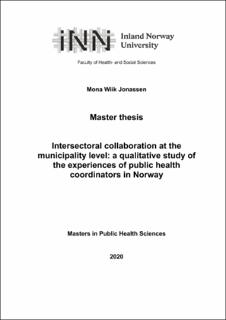Intersectoral collaboration at the municipality level: a qualitative study of the experiences of public health coordinators in Norway
Master thesis
Permanent lenke
https://hdl.handle.net/11250/2680413Utgivelsesdato
2020Metadata
Vis full innførselSammendrag
Abstract
The aim: To explore and understand public health coordinators’ experiences of intersectoral collaboration and Health in All Policies (HiAP). The research aims to shed light on the everyday reality of working to take forward the municipality’s systematic public health work and reveal the constraining and enabling processes and factors.
Method: A qualitative cross-sectional study of eight public health coordinators from eight different municipalities on the East and West coast of Norway. The method of data collection was semi-structured individual interviews. The data were analyzed using a thematic analysis approach. Based on participants’ experiences, processes were analysed with inductive reasoning and informed by concepts and literature on intersectoral collaboration.
Results: Nine themes were developed and further divided into two categories. Including category (i) professional capability, with themes 1) working across boundaries, 2) understanding roles and responsibilities, 3) understanding public health work, 4) public health as additional work, 5) team meetings as effective and meaningful. Category (ii) organisational structures, with theme 6) having a mandate for public health teams and overview document. Three themes were placed between the two categories, 7) purpose of public health teams, 8) overview document as a shared task and 9) collaboration as a long-term process.
Conclusion: Public health coordinators experiences of collaboration varied, for some, intersectoral collaboration was less present, while others seemed to have stable well-working public health teams. The findings indicate that public health coordinators had different preconditions and capabilities to work across boundaries to facilitate collaboration. The findings of this study suggest that public health coordinators in full-time positions, who can use boundary spanning processes have the potential to enhance the implementation of the principles of the Norwegian Public Health Act and achieve sustainable public health teams, that can ensure HiAP.
